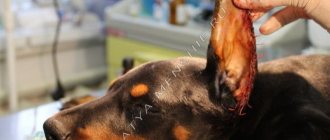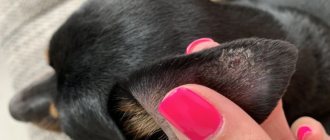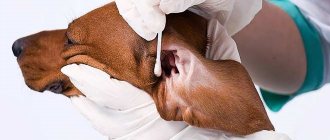Red ears in a dog are not uncommon. The hearing organs of a pet are quite vulnerable. Owners often notice that their pets scratch their ears from the inside. Looking there, you can see redness, and the ears, in most cases, are hot to the touch. It is not always possible to immediately take your dog to a veterinary hospital, so it is advisable to know the reasons for this phenomenon, and also how to provide first aid to your beloved pet.
Dog's ear is swollen
If a dog's ear is swollen, this is a signal to the owner that not everything is in order in the animal's body and it needs to be shown to a veterinarian. Ears are one of the sensitive organs and a kind of indicator of a dog’s health. It is impossible to make a correct diagnosis on your own, and even more so, it is categorically impossible to start treatment “blindly”.
Possible consequences of the disease
If the dog does not receive proper treatment in a timely manner, or the disease goes too far, the following complications may appear:
- chronic otitis;
- hearing impairment, including persistent ones;
- difficulties with feeding - due to constant pain in the ears, the dog may refuse solid food;
- discharge of purulent contents through the eyes;
- strabismus.
All these consequences threaten serious problems for the pet, so it is the duty of a good owner to quickly contact a veterinarian for help.
Symptoms: what to look out for?
When a dog has a swollen ear, along with swelling, there may be other signs:
- Behavior change.
- Severe or mild discomfort.
- Tilt of the head to one side (permanent).
- Sudden changes in behavior (apathy, aggression, if you hurt your ear).
- Myositis, unilateral overstrain of the neck muscles (with prolonged head tilt).
- Nervousness, insomnia, anxiety.
- Anorexia.
When there is pain in the ear, itching, the dog constantly fiddles with it, scratches it, and whines or squeals if it strongly touches the inflamed tissue with its claw. With certain diseases, there may be specific discharge, from serous to purulent, with an unpleasant odor.
Important! If you notice a swollen ear in a dog or one or more symptoms, contacting a veterinary clinic is mandatory. A timely diagnosis and treatment will reduce the likelihood of complications and, in certain cases, eliminate death.
How to treat red ear at home
Any problems with the ears are fraught with unpleasant consequences, so do not ignore alarming symptoms.
It is not always possible to help your pet on your own, and self-diagnosis is often erroneous.
If there are alarming symptoms, take your dog to the veterinary clinic, where doctors will analyze the ear scraping. Laboratory analysis will indicate the correct diagnosis and help prescribe the correct treatment.
Depending on the diagnosis, use:
- antibiotics (erythromycin);
- antiparasitic (amidel-gel, dekta) and antibacterial (surolan, tetracycline ointment);
- anti-inflammatory and other medications.
Erythromycin ointment
TOP 10 causes of ear tumors
The most commonly affected dog breeds are those with floppy ears. This is explained by poor ventilation of the dermis and the fact that pronounced pathology is often hidden from the owner until the last.
The dog's ear is swollen, due to which:
- Ear mite.
- Otitis (inflammation of the outer ear).
- Allergic reactions (including to food).
- Traumatic injuries (hematomas).
- Foreign bodies.
- Bacteria, fungi, yeast (malassezia).
- Hypothyroidism (poor functioning of the endocrine glands).
- Oncological diseases (benign and malignant neoplasms).
- Immune pathologies, congenital anomalies.
What exactly is the reason behind the swelling of the ear and changes in the dog’s well-being - the veterinarian will tell you after examination, examination, and tests. Treatment depends on the diagnosis, degree of complication, course of the disease and involvement of periarticular (adjacent) tissues in the pathological process.
First aid for redness
If a tick is found, it is removed independently or in a clinic . This is not a very complicated procedure, especially since tools for effectively capturing attached parasites have appeared on the market.
Important! If a foreign body is lodged in the ear canal that you are unable to remove (due to the depth of penetration), do not risk it - take the dog to the hospital. Inept actions will only aggravate the situation - you will only push the foreign object even further.
To stop allergic manifestations, give your pet (based on its weight and age) any antihistamine. This will relieve ear redness and itching, but will not get rid of allergies. If you don’t want to test your animal for allergens, try to find the irritant yourself.
There is a special technique for this, with a step-by-step elimination of foods/types of food: it will take more than one day or even a week, but you will understand what food causes an allergic response.
If you focus on industrial food, try switching the animal to a new, dietary line of products or switching to a natural menu. In the latter case, the products are not mixed, but introduced gradually, observing the dog’s reaction.
If you were unable to detect the allergen, and your pet’s ears are still red and itchy, you will have to visit Aibolit.
Return to content
Otitis in a dog: symptoms and treatment
Often common in lop-eared dogs (poodle, basset hound, spaniel, etc.). The cause of the inflammatory process is the penetration of water into the ear during swimming, hunting, or improper washing of pets. Since the auricle is not open, there is no air access, it does not dry naturally, inflammation, swelling, and weeping develop.
The dog begins to shake its head, worry, scratch the affected ear or rub it on the floor or objects. Upon examination, pronounced swelling, eczema (redness of the skin) is visible, there is a specific, sickly-sweet odor, discharge from serous to purulent.
The pet stops eating, becomes restless, and aggressive if the owner wants to examine or clean the ears.
If your dog's ear is swollen due to external inflammation, your veterinarian will tell you what to do. Diagnosis, identification of the root cause and its elimination will be required. Without this condition, therapy is not effective.
What to do:
- Relieve pain, itching.
- Strengthen your immune system.
- Remove serous, purulent discharge.
- Detoxify the body, etc.
Often, when the ear canal becomes overgrown, plastic surgery is performed to restore tissue. One-sided symptomatic treatment leads to chronicity of the pathological process.
The following drugs are prescribed: Otifri, Otoklin, Chlorhexidine (antiseptic), Levomekol, Oritsin, Otinium, etc.
Accuracy and prevention
Good hygiene practices are used to reduce the likelihood of developing diseases. Care and constant care of the ear canals will keep the hearing organs in good condition and also prevent the proliferation of pathogenic microflora. It is recommended to purchase sterile cotton wool, sanitary swabs and cotton pads in advance.
Ear care is carried out using prophylactic agents in the form of solutions, lotions, etc. The cleaning liquid is applied to a cotton swab and the inside of the auricle is thoroughly treated. The procedure is carried out regularly, at least 1-2 times a week.
Owners of long-eared dogs must comb out the fur of the ears and remove accumulated dirt, fragments of plants, insects, etc. In addition, representatives of long-haired breeds with hanging ears require regular grooming.
Actions aimed at preventing ear diseases:
- treating wool with preparations against fleas, ticks and other parasites;
- anthelmintic therapy;
- increasing immunity;
- identification of exposure to allergens contained in feed or hygiene products.
After long walks or stay outside the city, a mandatory examination of the pet’s ears is necessary, assessing the cleanliness of the canals and the skin around it. If redness is detected along with itching, pain, the appearance of pus and general anxiety, the dog must be taken to the veterinarian.
Inflammation of the middle ear
The disease often develops as a consequence of untreated otitis media and the transfer of inflammation from the external ear. Or due to a general infectious process (plague). Dogs experience difficulty chewing, swallowing, pain when opening their mouths, and discharge from the nose and eyes. The pet tilts its head towards the sore ear, its temperature rises, and there is no appetite. Complications include meningitis, incoordination of movements, etc.
Treatment is local, removing swelling, inflammation (antiseptics) and general, aimed at eliminating the underlying disease.
Symptoms
The owner can easily recognize the first symptoms of otitis media in a dog:
- often shakes his head, claws at the sore ear and reacts to touching it;
- upon examination, discharge with an uncharacteristic odor and swelling are noticeable;
- the ear is hot to the touch;
- The dog lies down more and turns away from the food.
If you notice such symptoms, you should consult a doctor.
Otodectosis
If a dog's ear is swollen and there is fluid inside, it could be otodectosis, an ear mite. The disease is accompanied by severe itching, redness of the skin on the inside of the ear, and a black-brown oily coating (a waste product of a tick). Then the exudate begins to flow out, the fur around the ear sticks together, there are scabs and crusts.
Severe inflammation leads to perforation of the eardrum, hearing loss and swelling to the internal structures. The dog is sitting with its head down to one side, the temperature is elevated. If inflammation affects the meninges (affects the central nervous system), there may be seizures and convulsions.
The diagnosis of otodectosis must be confirmed by laboratory tests (scraping and microscopy). The smear reveals the mite Otodectes cynotis.
Comprehensive treatment using:
- Anandina.
- Amitrazine.
- Otovedina.
- Drops, spray Bars.
- Gelya Ivermek.
- Drops Tsipam.
Therapy can be carried out at home following the recommendations of a veterinarian. Before treating the auricle with drugs, it is imperative to remove exudate, crusts, and all dirt. If you don’t do this, therapy makes no sense and the pathological process will only get worse.
Allergic otitis media
More often it develops due to an allergy to food or hormonal imbalance. The disease is accompanied by severe swelling, redness of the skin on the inner surface of the auricle, serous discharge and an abundance of wax.
The allergy is accompanied by a fungal infection (Malassezia), additionally creating problems such as severe itching, scratching, and damage to the dermis. The nature of the discharge changes to purulent.
Treatment – elimination of the cause of the allergy (change of food or treatment of endocrine diseases). Antipruritic drugs are prescribed - Sofradex, Triderm, Otodepine.
What do the ears of a healthy dog look like?
If the dog is healthy, its ears are pale pink. Sometimes slight sulfur secretions appear, which protect the animal's ear canals from contamination. Healthy dog ears feel cool to the touch. There should be no foreign secretions or unpleasant odor. Peeling of the ears is also unacceptable. It speaks of deviations from the norm.
It is necessary to periodically (once every two weeks) clean the ear cavity of wax using cotton pads or swabs. To do this, use a special ear cleaning product, which can be purchased at any pet store. You can also buy ear drops there and instill them to prevent ear mites.
Hematoma
If a dog has a swelling in the ear with fluid, there is a suspicion of damage to the blood vessels and bleeding between the cartilage (perichondrium) and the skin. This happens when:
- Intense scratching and damage to the tissues of the auricle with claws.
- Bites of other dogs (cats).
- Blows, falls.
- Shaking the long ears as they hit each other.
After injury, the hematoma grows quickly, is hot on palpation, with reddened or bluish skin. The tumor worries the dog, it shakes its head and tilts it to the side.
3 days after the injury, the hematoma begins to crepitate (crunch), then thickens, and the pain decreases. If the hematoma is large or at risk of infection, the veterinarian will perform minor surgery.
Tumors (neoplasms) of various origins
In the area of the outer (less often inner) ear in dogs older than 5 years, as well as in those who have had otitis media, otodectosis, etc., without receiving normal treatment, tumors may occur. Visually, minor inflammation, looseness, folding of the skin or obvious pathological growths are visible. In advanced cases or with a malignant course of the disease, there is an unpleasant odor from the ears and discharge.
Treatment is based on the results of the examination. If the tumor is external, easily accessible and small, surgery is warranted. In case of multiple processes, tissue changes, or a critical age of the dog, the veterinarian may refuse removal and prescribe symptomatic (local) treatment.
How often should you visit the veterinarian?
The frequency of visits to the veterinarian should be determined individually, based on the physical condition and age of the dog. There are recommendations for each age, which will be discussed further.
- Dog less than 1 year old: a monthly visit is recommended. It is up to one year that young pets need to have all the necessary vaccinations. The doctor also monitors the development and growth of the dog, whether there are any problems due to a lack of minerals, vitamins, and whether the development corresponds to age. A qualified doctor will definitely draw up a schedule of visits after a thorough examination of your pet. During this period, it is advisable to find a veterinarian who would monitor the dog throughout his life. A kind of family doctor, only for your beloved dog.
- Ages 1-7 years: Recommended annual examination. When the dog is one year old, you need to continue vaccinations according to the previously prescribed veterinary calendar. Don't forget about the annual examination, during which your pet will be thoroughly checked: ears, eyes, nose, heart, lungs, mouth. Only a detailed examination can guarantee the identification of possible symptoms of disease in certain organs. Based on the results of the visit to the veterinarian, recommendations regarding dental care, nutrition, physical activity, etc. will be offered. If there is a suspicion of illness, then additional examinations and tests will be prescribed.
- Ages 8 years and older: Visit your veterinarian every 6 months. Old dogs, like people, are at risk and are more susceptible to various diseases. For this reason, you should visit the veterinarian every six months. In addition to standard examinations, the doctor may prescribe urine, blood, stool tests, x-rays, ultrasound, and blood pressure measurements.
Cases when a trip to the veterinarian should not be postponed
When the dog feels well and no deviations in behavior are observed, it is necessary to visit the veterinarian according to a previously drawn up schedule. However, there are some emergency situations that require emergency assistance from a qualified specialist:
- severe breathing problems are observed;
- the dog was hit by a car;
- the pet does not wake up and is unconscious;
- the dog fell unsuccessfully from a height;
- incessant diarrhea and vomiting throughout the day, pale gums, diarrhea with blood;
- suspected paw fracture or other injury;
- the dog ate something poisonous;
- seizures with convulsions;
- the pet has fallen and does not get up;
- felt a tumor;
- the animal suddenly lost orientation in space;
- the dog whines, hides and trembles;
- other unnatural behavior of the pet.
The dog's ears are red inside and itchy: reasons, what to do
Diagnosis and identification of causes
If the owner notices that the dog’s ear is swollen, it is necessary to contact a veterinary clinic. Diagnosis is carried out comprehensively in order to identify the cause of the symptom and further prescribe treatment.
Using an otoscope, the external auditory canal, middle ear, eardrum and skin as a whole are examined. Foreign objects that could cause swelling are excluded, the presence/absence of exudate, pain, and erythema is noted.
Laboratory research:
- Blood to check for allergies to the hormones thyroxine and triiodothyronine.
- Cytology of ear secretions to study microflora, the presence of a tumor, autoimmune diseases, etc.
- Microscopy of exudate, skin scrapings from the ear to identify mites.
As a supplement, the veterinarian prescribes x-rays (polyps, tumors of the nasopharynx that lead to otitis media). Complete data on the condition of the internal structures of the ear, nose and throat will be provided by CT and MRI.
Only on the basis of research, the veterinarian diagnoses the dog, finds out the cause of the ear tumor and prescribes treatment.
Causes of redness
At risk are breeds with long floppy ears (dachshund, poodle, spaniel, basset hound, some terriers and more). But from time to time other dogs also suffer from ear sores accompanied by redness of the ear.
Redness is often accompanied by itching, pain and accumulation of fluid with an unpleasant odor . The animal shakes its head, scratches its ears until they bleed, loses its appetite, sleeps poorly (wanders from place to place). Sometimes your pet's temperature rises. The doctor will tell you what exactly caused the redness of the inner surface of the ear, and the owner’s task is not to delay visiting the veterinary center.
Allergy
Any substance (more often a food ingredient) can act as a provocateur; after it enters the body, the ear turns red, the skin flakes and becomes covered with pimples, and severe itching begins. In severe cases, purulent yellowish-gray discharge appears.
Important! The culprits of allergic otitis are both atopy (hypersensitivity to environmental components) and food allergies, which are common in dogs.
Food irritants are often fish, yeast, chicken, rice, wheat and oats, but it is possible that your dog will react negatively to some other foods.
Infection and parasites
Unnoticed allergic otitis media is often complicated by a secondary infection (fungal or bacterial) . In this case, the epidermis of the external auditory canal not only turns red, but also thickens (in chronic forms of the disease), and a high concentration of sulfur is observed. If neglected and complicated by infection, otitis media can lead to complete loss of hearing; moreover, a chronic disease is less easily treated and causes noticeable discomfort to the dog.
Ear itching and redness are also characteristic of parasitic diseases, such as:
- demodicosis;
- otodectosis;
- cheyletiellosis.
In addition, with a parasitic infection of the ear, moist or dry dark brown discharge is formed in it.
Foreign body
As a rule, it gets into the ear canal of dogs (especially hunting ones), which often walk in forested areas. A limited area of redness will indicate that a foreign body, for example, a seed or a blade of grass, has entered the ear. In this case, you can do it yourself - remove the irritant from the dog's ear.
Other aspects
Ear injury
Dogs with large ears sometimes injure them during active play, resulting in bruises. With a hematoma, the ear not only turns red, but also becomes noticeably hot, which indicates a ruptured blood vessel.
With this damage, blood often accumulates between the skin and cartilage, which leads to severe swelling of the auricle.
Poor ventilation
A wide ear blocks the passage of air, causing moisture to accumulate in the inner ear canals, which allows pathogenic bacteria to multiply easily. The solution is early ear cropping . This operation is necessary not so much for the pet’s appearance as for its health.
Vestibular disease (peripheral)
Redness can be a sign of damage to the middle or inner ear, in which the dog loses balance and orientation. This means that the vestibular apparatus of the animal is affected.
Symptoms to watch out for:
- the head is unnaturally tilted to one side;
- the ear turns red and hurts;
- the dog spins/falls towards the head tilt;
- nausea and vomiting;
- It hurts the dog to open its mouth and chew;
- loss of appetite.
Bathing
Ears often turn red after an unsuccessful bath, when water gets into the ear canal and causes inflammation. When washing in the bathroom, always plug your pet's ears with cotton balls, and when outdoors, remove moisture with a swab.
Also, the inner surface of the ear may change color to red after a tick bite.
Return to content











